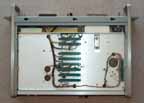General Info



The HP 117 VLF comparator was used to compare a house standard aginst the 60 kHz WWVB transmissions from Fort Collins CO.
There is a loop antenna that has filtering to reject near by RTTY stations and amplification.
The rack unit has a Tuned Radio Frequency (TRF) design, not a mixer type receiver. There is a meter and paper plotter to display and record the phase difference between the house standard and WWVB.
WWVB "upgraded" the signal format to include phase modulation to improve reception (mainly for the East coast), but that change makes this phase comparison receiver non functional. Experimentation started in 2011 and I think the broadcasts started around 2013. There is a way to precondition the off air signal to remove the phase modulation and thus allow receivers that depend on the phase to function.
There are two versions of the antenna, mine uses 2 each 13CW4 Nuvistors and the other uses FETs. The 117A puts out 27 VDC on the antenna connector to power the remote active loop. The 35 VDC fuse blows if you short the Antenna connector.Dymec DA100 Active Antenna
The Plot (DA100_28Jul01.tif) is the output of the DA-100 active antenna with the control set for %) Ohms and 10 dB of attenuation, which is the position that the HP 117A likes the best, 0 dB overloads the 117A! This plot took just under 20 minutes to make becuuse the RBW & VBW were set to 1 Hz. This puts the noise floor at about -130 dBm. The broad peak to the right is the 100 kHz LORAN system with a peak at -92.2 dBm. The 68.55 kHz signal is my HP M70 monitor.The 60 Kc Test Output plot ( 117T60out.tif ) from 50 to 70 kC shows 60 kHz as the strongest signal, but the other stations are still there. I don't know how important this is.
The front panel 100 kHz output ( 117out100kc.tif ) has the nearest sidebands (+ & - 120 Hz) down 20 dB and the frequency is right on.
B&W 1.8-30 Antenna
Connecting ground and center together does NOT work. The raw signal coming from the antenna has only a 10 dB signal to noise ratio.
Apparently the 117A wants a better S/N. WWVB is not one of the 7 strongest signals in the 0 to 120 kHz frequency range.
See AMRAD LF Active Whip Antenna for spectrum plots.
Amidon Ferrite Rod R33-050-750 Loop Antenna
This is the active loop that's part of the Bob Roehrig, K9EUI WWVB 60 KHz frequency standard published in the Jan, Feb and March 1994 issues of 73 Magazine. Material 33 is a manganese-zinc material having low volume resistivity. Used for low frequency antennas in the 1 KHz to 1 MHz frequency range. Available in rod form only. The above part number is for a 1/2" diameter by 7.5" long rod.FAR Circuits - has the 6 board set for the Bob Roehrig project. They also have article reprints.
The 100 Kc crystal is exposed to the air. I got better performance by blocking the right side vent holes.
Maybe more insulation at the crystal would be better?
The top cover is held on with 2 Posidrive #2 screws.
At the top front you can see the top of the 100 kC crystal.
On the right side is the TRF amplifier. It uses 4 each 7587 Nuvistors.
On the second board back from the front you can see a 6CW4 Nuvistor.
The bottom cover is held on with 2 Posidrive #2 screws.

The transformer at the top left was made by PAECO (Palo Alto Electronics Company?) which was one of the companies owned by HP. Another HP captive company that made systems from HP boxes was dymec
(spelled with a lower case "d") so that the HPlogo parts could be installed upside down to make dymec
logo parts. At the beginning they used DEC PDP-11 computers. Latter HP made the 2114, 2115 and 2116 core memory computers so that the complete rack would have HP products.Later HP came out with HP-IB and after putting that in the public domain it was called IEEE-488.
At this time each interface to a box was customized for that box and there was an I/O card in the computer for each box.
I interviewed for a job at HP working on computers in the mid 1970 time frame and never heard from them so I stayed where I was and took a big pay raise. Weeks later the engineer that interviewed me called to ask what I was doing since he had made an offer, but he was surprised to learn the HR had not given me the offer.
So I didn't go to work for HP then.
See my Rack web page for info on HP serial numbers - date codes.
This is the [an error occurred while processing this directive] time this page has been accessed since since 27 July 2001